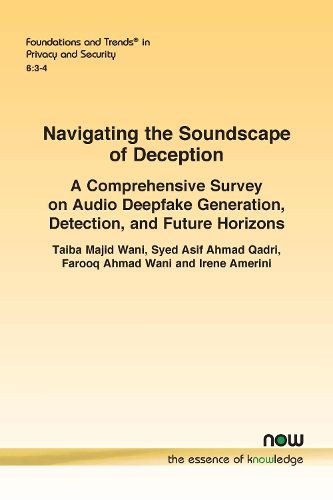Readings Newsletter
Become a Readings Member to make your shopping experience even easier.
Sign in or sign up for free!
You’re not far away from qualifying for FREE standard shipping within Australia
You’ve qualified for FREE standard shipping within Australia
The cart is loading…






This title is printed to order. This book may have been self-published. If so, we cannot guarantee the quality of the content. In the main most books will have gone through the editing process however some may not. We therefore suggest that you be aware of this before ordering this book. If in doubt check either the author or publisher’s details as we are unable to accept any returns unless they are faulty. Please contact us if you have any questions.
The rise of audio deepfakes presents a significant security threat that undermines trust in digital communications and media. These synthetic audio technologies can convincingly mimic a person's voice, enabling malicious activities like impersonation, fraud, and misinformation. Addressing this growing threat requires robust detection systems to ensure the authenticity of digital content.
In this monograph, a comprehensive analysis of the state-of-the-art techniques in audio deepfake generation and detection is provided. Various methods used to generate audio deepfakes are examined, including Text-to-Speech (TTS) and Voice Conversion (VC) technologies, and their capabilities in producing highly realistic synthetic audio are discussed. On the detection front, a wide range of approaches are explored, encompassing traditional machine learning and deep learning models for feature extraction and classification. The importance of publicly available datasets for training and evaluating these models is emphasized, showcasing their role in advancing detection capabilities. Additionally, the integration of audio and video deepfake detection systems is discussed, providing a comprehensive defense against sophisticated attacks.
This monograph critically assesses existing methods and datasets, highlighting challenges like the high realism of deepfakes, limited data diversity, and the need for models that generalize well. It aims to guide future research in enhancing detection and safeguarding digital media integrity.
$9.00 standard shipping within Australia
FREE standard shipping within Australia for orders over $100.00
Express & International shipping calculated at checkout
This title is printed to order. This book may have been self-published. If so, we cannot guarantee the quality of the content. In the main most books will have gone through the editing process however some may not. We therefore suggest that you be aware of this before ordering this book. If in doubt check either the author or publisher’s details as we are unable to accept any returns unless they are faulty. Please contact us if you have any questions.
The rise of audio deepfakes presents a significant security threat that undermines trust in digital communications and media. These synthetic audio technologies can convincingly mimic a person's voice, enabling malicious activities like impersonation, fraud, and misinformation. Addressing this growing threat requires robust detection systems to ensure the authenticity of digital content.
In this monograph, a comprehensive analysis of the state-of-the-art techniques in audio deepfake generation and detection is provided. Various methods used to generate audio deepfakes are examined, including Text-to-Speech (TTS) and Voice Conversion (VC) technologies, and their capabilities in producing highly realistic synthetic audio are discussed. On the detection front, a wide range of approaches are explored, encompassing traditional machine learning and deep learning models for feature extraction and classification. The importance of publicly available datasets for training and evaluating these models is emphasized, showcasing their role in advancing detection capabilities. Additionally, the integration of audio and video deepfake detection systems is discussed, providing a comprehensive defense against sophisticated attacks.
This monograph critically assesses existing methods and datasets, highlighting challenges like the high realism of deepfakes, limited data diversity, and the need for models that generalize well. It aims to guide future research in enhancing detection and safeguarding digital media integrity.